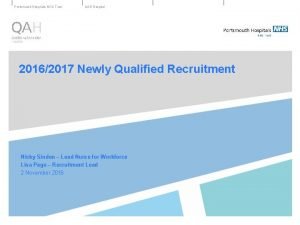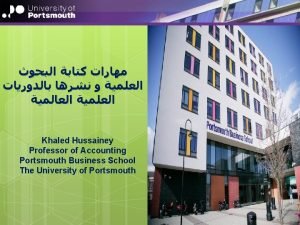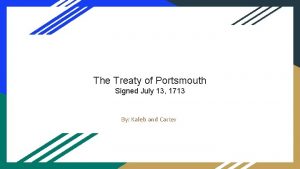Medieval Portsmouth Royal Charter and growth of Portsmouth















- Slides: 15

Medieval Portsmouth Royal Charter and growth of Portsmouth On 2 May 1194 King Richard I gave Portsmouth its first Royal Charter granting permission for the city to hold a fifteen day annual fair (which became known as the Free Market Fair), weekly markets (on Thursdays), to set up a local court to deal with minor matters, and exemption from paying the annual tax ("farm") of £ 18 a year— instead the money would be used for local matters. How would a market improve peoples’ lives? Why was fire such a danger in towns during this period? In 1369 a military governor was appointed who was responsible for the defence of the town. However Portsmouth was burned down 4 times during the 14 th century during a period of almost continuous warfare between England France. The French burned Portsmouth in 1338, 1369, 1377 and 1380. The great tower was built at Portchester Castle. Built across the northwest angle of the Roman fort, it is the architectural showpiece and symbolic focus of the castle. Built (in its first stage) in about 1130. It is an outstanding example of castle building as a representation of wealth and status, rather than merely defensive fortification.

1449 Excommunication - The Bishop of Chichester, Adam Moleyns, was murdered outside of the church, whilst on the business of Henry VI. The bishop had been sent to the church, with instructions to pay the soldiers and sailors based at the garrison. There was disagreement as to the correct amount that should be paid and as a result the Bishop was murdered. (English Chronicles written in 1495) “They took him out of the Domus Die, (Garrison Chapel) on to what is now the Parade Ground, and there they stoned him to death”. Impact of excommunication As punishment for this the town of Portsmouth was excommunicated by the Catholic Church, meaning that no religious services could take place in the town. Many people believed that their bad luck was due to the excommunication. This excommunication lasted for 50 years until the citizens built a new chapel as reparation. Why might the chronicles be exaggerating the impact? Chronicles from the time says that Portsmouth suffered badly as the soil became infertile and there were numerous poor harvests and building were ravaged by fire. It was also said that ‘merchants, on account of the said crime and by reason of the infamy of such inhabitants, have been unwilling to call at the port there with their ships’. However, this didn’t deter Henry VII developing Portsmouth into a naval base in the 1490 s.

Tudor Portsmouth The Square Tower is among the earliest stone fortifications built in what is now known as Old Portsmouth. The tower was built in 1494 during the reign of Henry VII and was the residence of the military governor. Towards the end of the 16 th or early 17 th century the tower was adopted for use as a magazine (a place to store gunpowder and ammunition). Why were the French attacking England at this time? THINK Religion How could war perhaps be a positive for the people of Portsmouth? Southsea Castle was one in a series of forts constructed for King Henry VIII. The castle was built in great haste in 1544, prompted by Henry VIII's fears of a French attack on Portsmouth. • It was the first of its kind to be built in England, incorporating ‘trace Italienne’ which was a star shaped fortification. This meant it was built with lower, thicker walls to defend against cannon fire and angled bastions that meant there was no blind spots. • It was not long finished when on 18 July 1545, a French invasion fleet approached Portsmouth and landed on the Isle of Wight. Henry VIII was at Southsea Castle when the Mary Rose sank the next day.

Painting of the sinking of the Mary Rose in 1545. It also gives us a glimpse at what Portsmouth may have looked liked at this time. The population of Tudor Portsmouth continued to grow and it might have reached about 2, 500 by 1600.

1522 - A heavy iron chain was put across the entrance of the harbour by order of the King. These were used when the threat of invasion was high. Original links can be seen at Southsea Castle today. 1558 - Plague killed more than half of the population of Portsmouth and the surrounding area. 1560 – Plague strikes again killing 250 people in Portsmouth in March and October. 1563 – Plague strikes Portsmouth for the third time in five years killing 300 people. How do the people of Portsmouth benefit from the sea? 1585 - 7 th July. Roanoak colony establish in Virginia. This was the first English colony to be established in the new world and was commanded by Ralph Lane returned to Portsmouth for further supplies. The following year the supply ship found the settlement deserted and to this day no trace of the colonist have been found, it is known as the lost colony of Roanoak. When Lang returned to Portsmouth his sailors brought back Tobacco and potatoes. They are said to have astonished the inhabitants by smoking pipes as they walked streets of Portsmouth.

Stuart Portsmouth 1625 - Portsmouth again badly affected by plague. 1626 - 4, 000 soldiers based at Portsmouth. Seamen on naval ships were 3, 935 with 594 in other ships. Is having more sailors and soldiers living in the area a positive for Portsmouth? 1628 - The Duke of Buckingham put forward preparations for the construction of a double dock to be built in the dockyard. Unfortunately for Portsmouth the Duke of Buckingham was murdered on 23 rd August 1628 by John Felton, a disgruntled soldier who laid in wait and stabbed the Duke to death at what is now 11 High Street Old Portsmouth. Felton was later executed at Tyburn Tree and gibbeted on the beach at Portsmouth near where the present day Clarence Pier stands, but with the loss of the Duke‟s support so the great plans for the dockyard were lost. Seaman of the fleet in a state of mutiny for lack of clothing, food and pay. Southsea Castle is badly damaged by fire.

English Civil War (1642 -1651) - 1642 – Colonel Goering declared Portsmouth was to fight for the King and not Parliament in the English Civil War. Parliamentary forces captured Southsea Castle, bombarded Portsmouth from Gosport and forced the town to surrender. Following the end of the civil war in 1646 Portsmouth prospered. In 1650 a ship called the Portsmouth was launched in the Dockyard. It was the first ship to be built in the town for over 100 years. Between 1650 and 1660 12 ships were built in Portsmouth and the town was very busy. Its population had probably grown to over 3, 000. Wars against the Dutch - 1653 - Admiral Blake won a sea battle against the Dutch off the Isle of Wight. 11 warships, 30 merchant ships and 1, 000 Dutch prisoners were captured. Naval expenditure at Portsmouth increased from £ 6, 860 in 1625 to £ 13, 700 in 1653. The warship “Sussex” blew up in the harbour. 1654 - Mutiny in fleet because of bad food and conditions.

1665 - Plague in Gosport & Portsmouth killed more than 250 people. Samuel Pepys - 1661 – Described Portsmouth as a “pleasant and strong place”. Why would Pepys describe Portsmouth as a ‘strong place’? 1667 -85 - The fortifications around the town were rebuilt. New walls were built with many bastions (triangular towers). Afterwards Portsmouth was one of the most heavily fortified towns in Europe. 1667 - Parliament voted £ 600, 000 to build 30 new ships some of which were built at Portsmouth.

Eighteenth Century Portsmouth 1724 Daniel Defoe visited the town and described the Dockyard – “The strength of the town is also considerably augmented on the land-side by fortifications raised in King Williams time about the docks and yards” and “These docks and yards are now like a town by themselves, and are a kind of marine corporation, or a government of their own kind within themselves; there being particular large rows of dwellings, built at the public charge, within the new works, for all the principal officers of the place: especially the commissioner, the agent of victualing… the tradesmen likewise have houses here and many of the labourers are allowed to live in the bounds as they can get lodging. ” 1747 - 2 nd June. The first newspaper to be circulated in Portsmouth was the Portsmouth and Gosport Gazette. Read this source carefully. What can you infer from it?

1754 Dr Richard Pococke describes the docks – “They have from 1, 000 to 1, 500 men employed in the yard; The Academy is a handsome building for 50 youths to be instructed in theory and practice of Navigation”…Pococke refers to a “very noble hospital for the sick” at Gosport (Haslar Hospital) “one (wing) of which is almost complete”. How might war affect the people of Portsmouth uniquely? How might losing husbands and family at sea affect families back in Portsmouth? 1755 Royal Marines - first came to Portsmouth and billeted in Hilsea Barracks. They moved to Barracks in what is now Peacock Lane (originally Barrack Street) in 1783. From 1755 -1763, “The Seven Years War”, 133, 708 sailors lost due to disease whilst 1, 512 were killed in action.

1757 - An Admiral writing from his ship in Torbay declaring that the Plymouth beer was so bad that it employs the whole time of the seamen throwing it overboard. He praises the Portsmouth beer and begs to be supplied from that port. 1759 -. 2, 099 men employed in Dockyard How might these fires affect peoples living standards? 1760 - July 1760 a fire broke out just after midnight in one of the major storehouses of the yard that contained large quantities of pitch, tar, turpentine and other combustible materials that soon got out of control and spread to surrounding buildings. It was generally thought that lightning caused the fire as a great thunderstorm was ragging at the time. 1770 27 th July - A Great Dockyard Fire destroys most of the Yard. Had the wind not abated and changed direction the Town as well would have been lost. The material lost was said to be equivalent to equipping 30 men-of-war. 1776 December. - “Jack the Painter” (alias James Hill, or John Aitken) a sympathiser with the American rebellion, set fire to the Ropehouse which was gutted. He was hanged 64 ft high from the mast of the “Arethusa”, erected inside the Dockyard Gate, on 10 th. March 1777.

1795 Dr. George Pinckard‟s description of Portsmouth. “But here hordes of pollinating females are seen reeling in drunkenness or plying upon the streets with a broad modesty which puts the great orb of noon to the blush. These daughters of Cypria are not only of manner peculiar, but likewise of such peculiar figure and apparel that it were, perhaps, difficult in any other part of England to find a correct resemblance to the “Sweet Poll of Portsmouth”. Press Gangs The press gang, a group of 10 - 12 men, led by an officer, would roam the streets looking for likely 'volunteers', merchant seamen were particularly prized as they already had seagoing experience and needed less training. Old Portsmouth, seems to have been a favourite recruiting area due to the large number of pubs, hostelries and other establishments that existed there. Men would leave the pub drunk, get attacked by the press gang and then wake up on board a ship of war.


Growth of the town The new suburb or Portsea soon outgrew the original town, which became known as Old Portsmouth. In 1801 Portsea had a population of about 24, 000 while Old Portsmouth had less than 8, 000. In 1764 a body of men called the Improvement Commissioners was set up in Portsea. They had power to pave and clean the streets. They also appointed a man called a scavenger who collected rubbish, with a cart, once a week. In 1768 a similar body was set up in Old Portsmouth. In 1776 they were given power to light the streets with oil lamps and from 1783 they appointed night watchmen to patrol the streets. In 1733 a rich man left land in his will. The land was to be rented and the money used to provide a free school. Portsmouth Grammar School opened in Penny Street in 1750. Despite its founder's intention it later became a fee paying school. 1773 Portsea Old Portsmouth

A view of Portsmouth 1765
 Charterbare
Charterbare Growth analysis
Growth analysis Primary growth and secondary growth in plants
Primary growth and secondary growth in plants Primary growth and secondary growth in plants
Primary growth and secondary growth in plants Primary growth and secondary growth in plants
Primary growth and secondary growth in plants Step growth polymerization vs chain growth
Step growth polymerization vs chain growth Geometric growth population
Geometric growth population Neoclassical growth theory vs. endogenous growth theory
Neoclassical growth theory vs. endogenous growth theory Difference between organic and inorganic growth
Difference between organic and inorganic growth Compare and contrast trustee period and royal colony
Compare and contrast trustee period and royal colony Compare and contrast trustee and royal georgia
Compare and contrast trustee and royal georgia The orchards st james
The orchards st james Portsmouth hospital trust values
Portsmouth hospital trust values Khaled hussainey
Khaled hussainey Icg portsmouth
Icg portsmouth Why did the wabanaki sign the treaty of portsmouth
Why did the wabanaki sign the treaty of portsmouth





























